SuStainability
Sustainability: For our moose and their nature
We do many projects and try to adapt our work methods to be as sustainable as possible so our moose and planet will remain. Read about how we try to reduce, reuse and recycle resources and some of our current and future sustainability projects. Moose sadly face climate change challenges which we have described on another page. Read more about moose and climate change or continue to read about our sustainability.
Reduce
Reducing our resources is great for the environment, our CO2 footprint and it shows to be more cost efficient. Read more about our reducing initiatives below.
Reuse
Reusing materials that we once looked upon as waste helps us from acquiring new, costly resources. Read more about our reusing initiatives and plans below this.
Recycle
Recycling resources is a process of transforming our resources that we use both internally and externally. Read more about our reusing initiatives below.
The circle of moose
Browse our “circle of moose” and see how we are working in a closed resource cycle.

Reduce
We work hard on reducing the amount of external resources we use but running an animal park has many demands that we continuously try to find better solutions for. Here’s our current initiatives:
- Moose “snacks” from external resources
- Moose trees – see our project “A long term wooden vision” below
- The amount of berries we buy from external and instead forage berries ourselves to avoid plastic wrapping and additional cost
- External soil, fertilizer and planks for flower/moose snack garden beds
- Food waste is costly and by implementing our booking system and a new food strategy we can avoid food waste to a higher degree
- Plastic bags and plastic posting bags for our online store is now being faced out and replaced by 100% biodegradable materials
- Reducing clean water for gardening, moose ponds etc. will soon be substituted with a rain water collection system
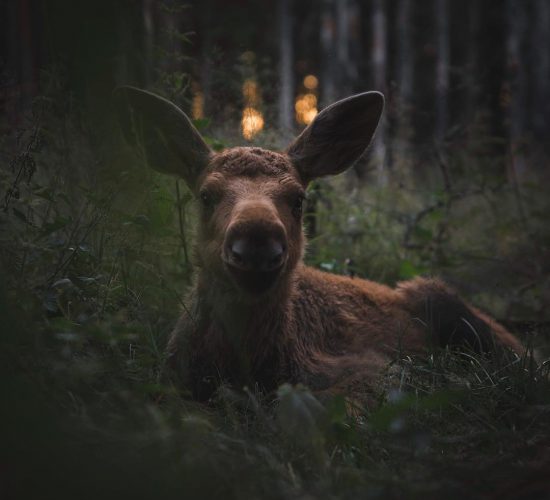
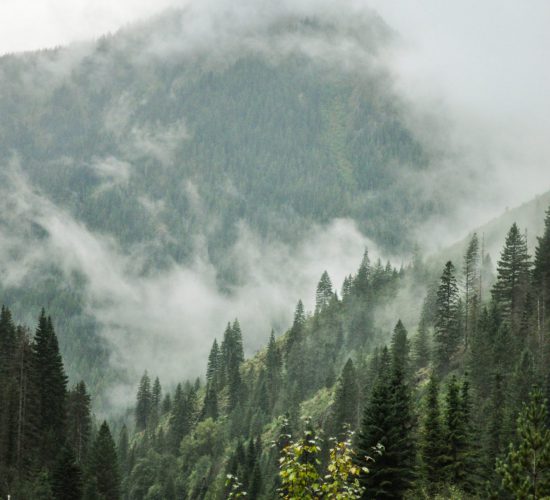
Reuse
Our moose park and forest area is filled with resources. The question is how to reuse them and we enjoy getting creative and use our resources in new ways! Here’s our current initiatives:
- Moose eat many trees and twigs but sometimes they are picky so we are collecting the majority of their leftovers to reuse in garden beds and in our compost – read about “Hugelkultur” below
- Coffee grinds are reused as snail protection for our flower beds
- Logs of birch and pine are being reused for many structural projects like benches, chairs, garden beds, enclosures and more!
- Through our store we receive large amounts of cardboard boxes which we reuse in both flower beds and for bigger shipment so we save resources on buying even more cardboard
- All cutlery, plates and cups are reused and cleaned on a “ECO” program by the dishwasher
Recycle
Recycling resources happens in different ways in our park. We are working on creating a circular recycling behavior on most resources. Here’s our current initiatives:
- Paper hand towels are recycled in our compost as a great resource of carbon to balance out too high nitrogen levels (from moose shit)
- We recycle the majority of our metal, glass and plastic wrapping from our café
- Moose eat an impressive selection of plants and trees so their poop is like gold. We recycle moose poop for 2 years so it breaks down completely in our compost to fertilize all plants for wildlife and guests to enjoy
- When our moose drop their horns every winter we collect and recycled them into decoration and antlers tools with a local horn expert
- A bigger selection of ECO-friendly products that are recycled or made from recycled materials
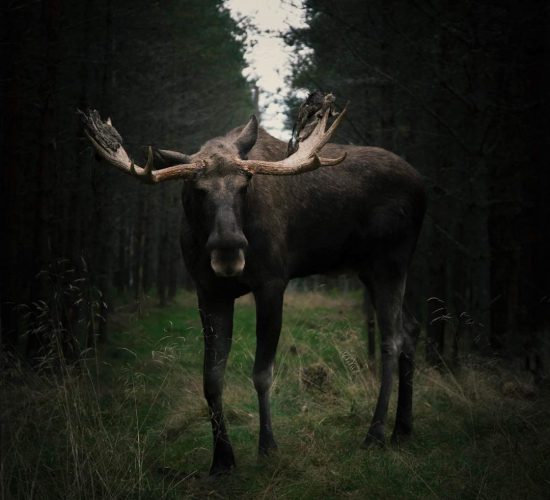
Small but important projects
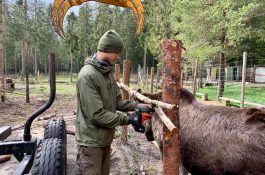
Natural enclosure
Our edible pine and birch feeding enclosure reuses 30 logs and the moose love eating the bark which gives us the option to show teeth marks.
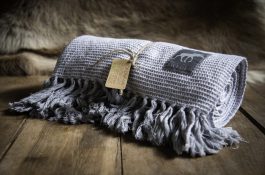
Recycled textile collection
A bigger selection of ECO-friendly products are recycled or made from recycled materials such as bamboo fibers, jute and much more!

Solar-powered cameras
Installing our moose cams which runs on solar power keeps the camera on 24/7. Convenient, cheap and really cool.
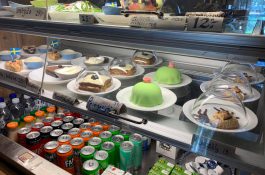
Food waste
Food waste is costly and by implementing a booking system and a new food strategy we avoid food waste in the same scale.
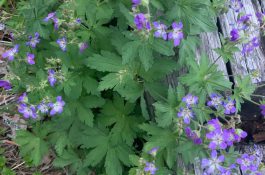
Native and hardy flowers
Introducing native plants back into the environment helps sustain the nature we wiped away to get perfect lawns. Moose love native flowers too!
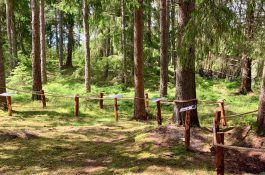
Recycled logs in fact forest
Our informational fact forest activity is made of several old reused pine tree logs. All wooden elements are reused in fact forest.
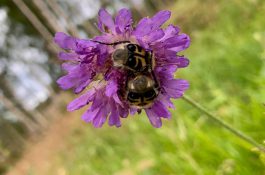
Pollinators paradise
We are introducing more plants and flowers that are a pollinators paradise to attract insects and bees for greater biodiversity.

Composting resources
We compost moose poop, food scraps, pellets and organic “trash”. We have a three stage system with heat compost and two 10 m2 areas with info boards.
Selected sustainable initiatives
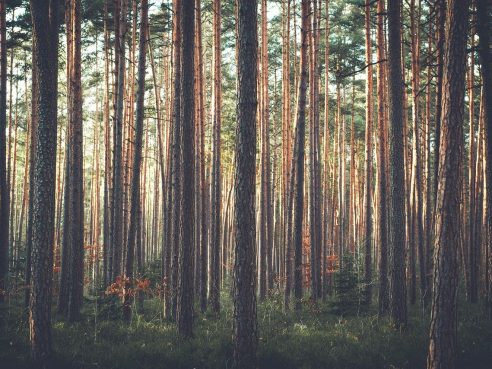
Green building: Own and local forest
Dalslands Moose Ranch is a family business from a dedicated nature family that privately owns several forest areas passed down by generations. Wood working and foresting with planting, harvesting and maintaining forests professionally is part of our DNA. There are various tree types in the forests with the majority being pine. The forests are private and closed off so all wilderness in the forests are living untouched. Thanks to the many generations of wood workers we also have access to the machinery that turns trees to usable building materials such as planks in every size we can dream of. This is a highly valued freedom and we also gather moose food trees from time to time in these large forest areas. The forests are all in a proximity of 15-20 km from the moose park making all transportation of logs, moose food and planks very limited. Thanks to our family forests we can build green and sustainable!
Hugelkultur: A special bed
This bed has all the moose’s top 8 favorite flowers! We have reused 9 birch logs to create a cool and natural triangular shape but to fill it up suddenly looked expensive. We wished that the bed should be build with water reduction in mind. A hugelkultur bed became the solution with lots of reused big and small wood pieces, branches, pine cones and dried weeds that acts as sponges and keep the moisture very long. The bed acts like a big compost and holds nutrient for 1-2 years and got 1 thin top soil layer. We have never seen so happy flowers and water flowers so little!
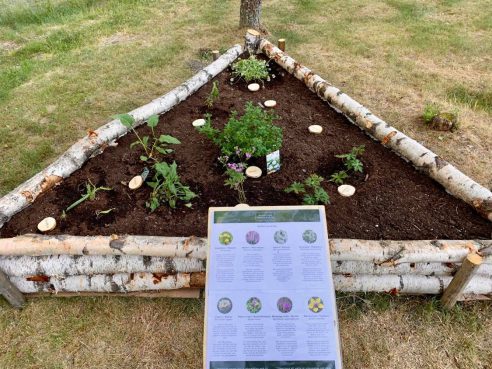
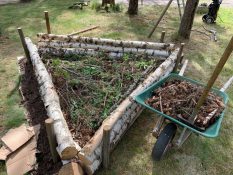

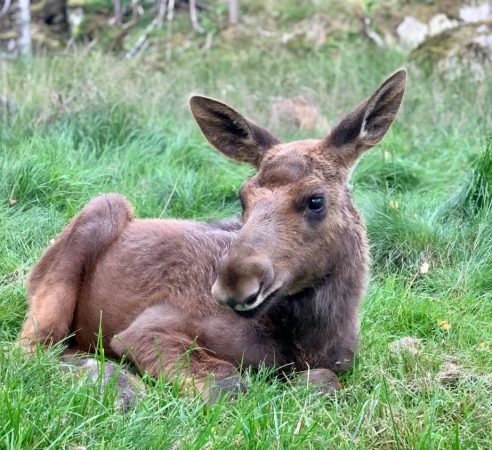
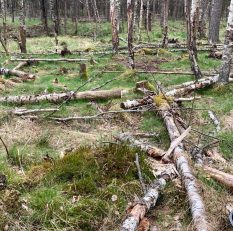
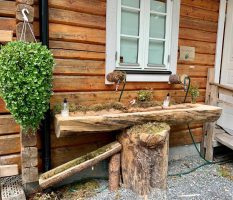
Mapping biodiversity: Nature's gift
A sustainable biodiversity is a gift for nature, our guests and us. Taking responsibility and facilitating an attractive environment is a great task but we already see great results. Our fallen, dead trees in closed off areas hosts many insects and helps boost the soil when broken down slowly. Our squirrel and bird buffets are very popular and with our reused wooden zink, all animals have the option to sip water from the wood cracks. Our small birds enjoy sitting on the moose and eating their pests like moose fly and ticks. To keep track of our biodiversity in the park and around the area we keep a wildlife and native plant list and map. Wildlife attract other wildlife and support a sustainable way of nature’s cycle. On our activity page you can see a selection of our identified wildlife.
A long term wooden vision
Moose eat an extreme amount of food every day. They need a balanced diet so when they are done with their healthy pellets they want trees. We try to provide them with as great as variety as possible but their forest reserve is coming to an end and now it primarily offers birch, asp and pine. We have a long term vision of growing new trees from cuttings in some of our smaller, closed off areas in the reserve where old trees are rotting and falling over. Our goal is that for every tree we remove we will plant two new to create a more sustainable and local food source so we avoid visiting our other forest areas where we have to drive to and harvest trees. It is a big project but we do not feel good about taking and not giving back to nature! Most of our cuttings are living in a kindergarten at our nature keepers home.
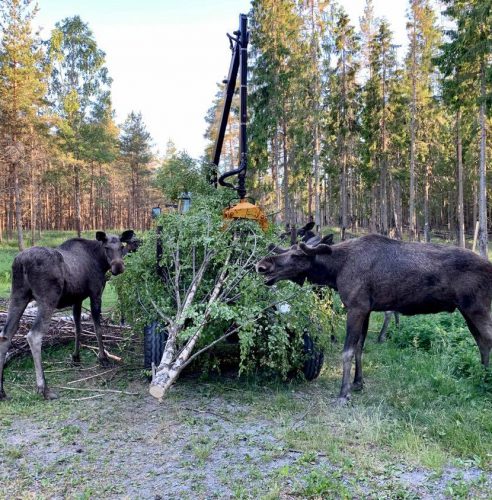
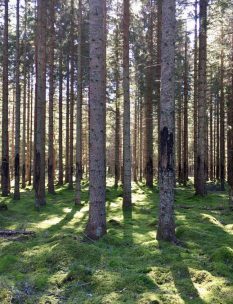

Future 2021 sustainable initiatives
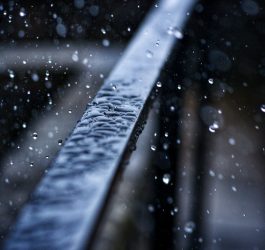
Collecting rain water
To save water resource we are planning a system so guests can wash hands outdoor in rain water and we can provide rain water for all our outdoor facilities incl. flowers, cleaning and moose.

Reused nature play area
We are restoring our old kids area in front of our moose park with reused logs of hard pine wood and building new and fun activities. We imagine it to look natural and in the style of this picture.

Green cleaning
Chemical and toxic cleaning products contribute to pollution in air and the water when cleaning buckets are emptied. We wish to buy green cleaning products to protect staff, guests and nature.
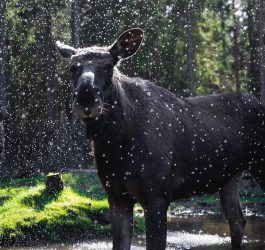
Bigger moose pond
We have three moose ponds and we wish to dig them bigger, deeper connect them and the deeper the better they hold (rain) water. Perhaps the moose’s favorite water plant, the water lilly, could thrive here too. We will try!
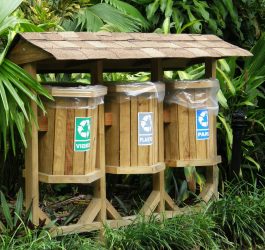
Trash sorting for guests
Unsorted trash gets burned in big facilities but could have been recycled if it was sorted. We often pick up trash after our guests so we wish to create a fun, informational trash sorting station for guests.
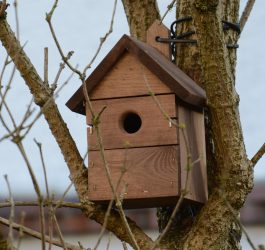
Bird homes
Providing shelter from birds is important for them to have a good habitat. It is also amusing for our guests to see nest builders in action and preparing the young ones for flying lessons. We will build some reused wood homes.
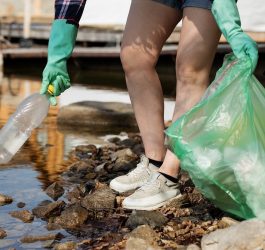
Bye, bye plastic
All our trash is gathered in plastic bags which we wish to replace with biodegradable plastic bags. We will sort all plastic and recycle it both in the kitchen and guest areas. Bye, bye (micro) plastic!
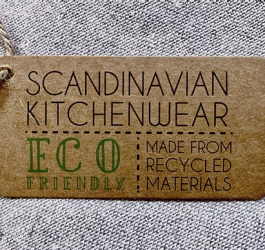
More ECO-friendly products
We are looking into increasing our amount of ECO-friendly products in both our physical store and online store. We are inspired by FN’s future fibers including jute, coconut and many more.
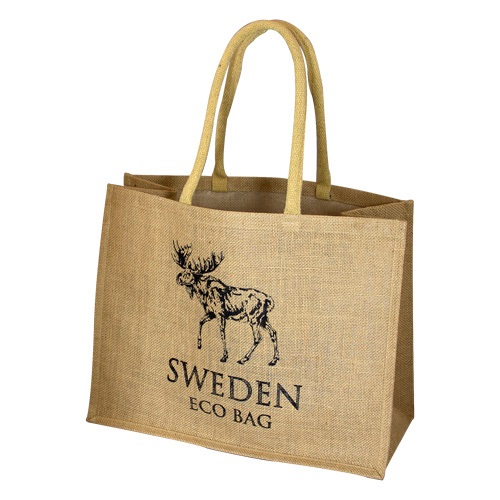
Future fibres: Jute
This amazing material is also known as one of the United Nations four “future fibres” and offers a list of environmental benefits. By choosing jute fibre you get a 100% biodegradable and recyclable material that does not generate any toxic gases when burnt like other textile materials. External and chemical fertilizers are not needed when cultivating jute thanks to its natural enrichment of the soil. Support nature’s ecosystem and future by getting some golden fibers!
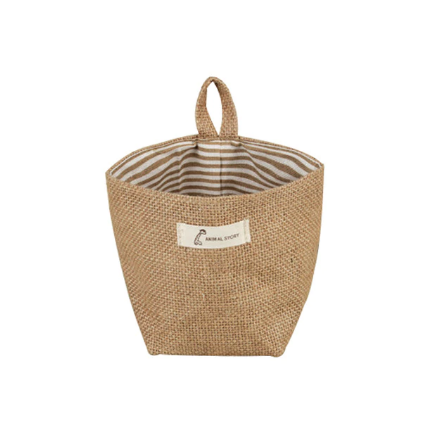
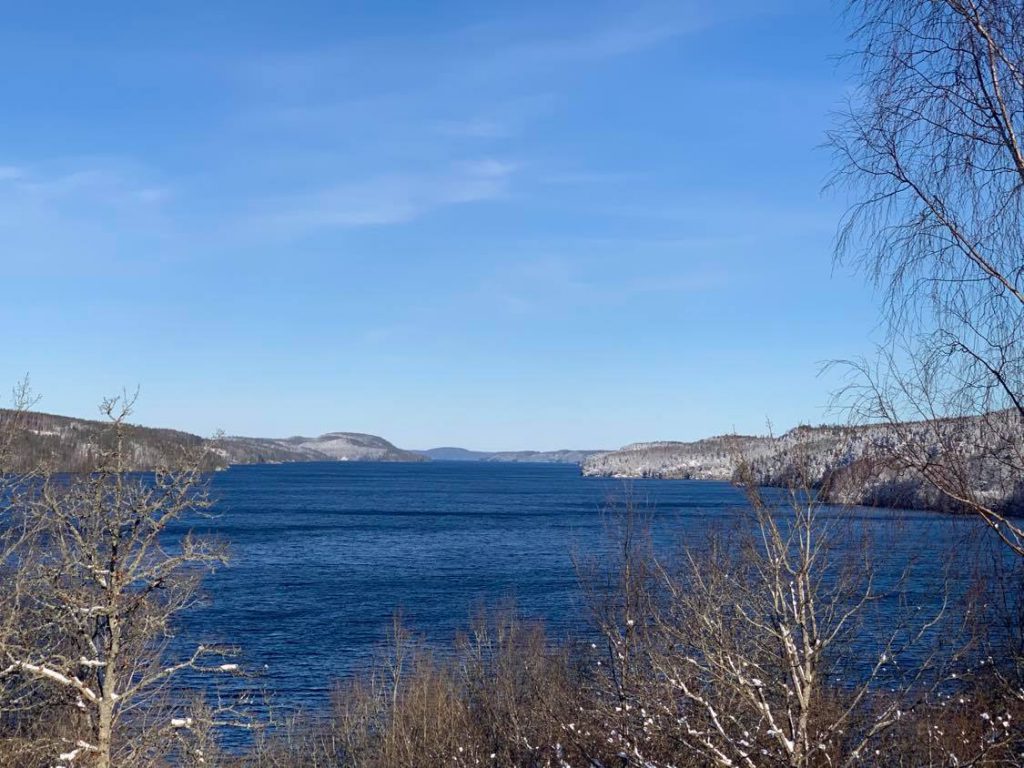
Greener transport?
If you want to visit us there are different greener options!
You can take the train and arrive at Ed train station. The station is 2,3 km from our park and it is a beautiful walk with the view of our amazing lake “Stora Lee” that is formed during the ice age.
If you have an electric car and need charging we have a couple of different charging options in Ed. The closest one is 1 km from our park right next to the gas station.